Immerse yourself in the enchanting world of German Warmbloods, equine marvels known for their remarkable history, unique attributes, and distinguished bloodlines. Dating back to the middle ages, these horses have played a crucial part in the culture and sports of Germany. Exuding power, precision, and a striking appearance, German Warmbloods carry an intriguing blend of characteristics that set them apart from other breeds. As we venture into their historical significance, physical characteristics, and groundbreaking performances in equestrian sports, you’ll gain a deeper understanding of their storied bloodlines and the breeding practices that have preserved their essence over centuries.
Table of Contents (Horspedia)
The History of German Warmbloods
German Warmbloods
German Warmbloods are a family of horse breeds that come from Germany. Known for their versatility, athleticism, and strength, German Warmblood horses are sought after across the globe for a variety of equestrian activities. The history of these remarkable horses is tied closely to the history of Germany itself, making them an important aspect of German heritage.
The Origin and Breeding of German Warmbloods
The history of German Warmbloods started in the Middle Ages when different breeds of horses were imported into the region of Germany from all over Europe. Monastic orders and German nobility brought in noble strains of horses to improve the indigenous breeds. The breeding process was selective, with a focus on producing offspring that were robust, athletic, and versatile enough to be used for a multitude of purposes such as farming, draft work, transportation, and later on, in warfare.
During the 19th century, many different breeds such as Thoroughbreds, Arabians, and Trakehners were introduced to enhance the speed, endurance, and refinement of the local Warmblood stock. Dedicated breed societies were established to monitor and govern the breeding process, ensuring the preservation of key traits and the quality of the resulting horses. These efforts resulted in the development of distinct but interrelated German Warmblood breeds such as the Hanoverian, Holsteiner, and Oldenburg.
German Warmbloods in German Society
Over the years, German Warmbloods have held a prominent place in German society. Beyond their practical applications in agriculture and transportation, these horses became symbols of social status, with the nobility often maintaining large stables. In the second half of the 20th century, as mechanization reduced the need for working horses, the focus of breeding Warmbloods in Germany shifted more towards creating refined sport horses.
It was during this time that German Warmbloods started to excel in international equestrian competitions. Their combination of strength, agility, and grace made them particularly well-suited to events such as dressage, show jumping, and eventing.
Contribution in Sporting Events
In the sphere of equestrian sporting events, German Warmbloods have made a significant contribution, consistently performing well in an array of disciplines at the international level. The breeds have been continually developed and refined to enhance their performance in various events, achieving global recognition.
German Warmbloods are known for their power in show jumping and grace in dressage. They have also stunned audiences and judges with their performance in three-day eventing – a true test of versatility. The Olympic Games and World Equestrian Games have seen numerous German Warmblood champions, cementing their place in equestrian history.
Origins of German Warmbloods
The compelling story of German Warmbloods is a reflection of the changing equestrian needs and interests over centuries. Starting from the sturdy workhorses of the Medieval Ages to today’s accomplished sports horses, the evolution of these breeds underscores the talents and determination of German breeders in producing top-notch horses. In today’s modern times, German Warmbloods stand as symbols of national pride and are important components of the nation’s cultural legacy. Their story is an impressive mix of tradition, planned breeding, and an unwavering drive for excellence.
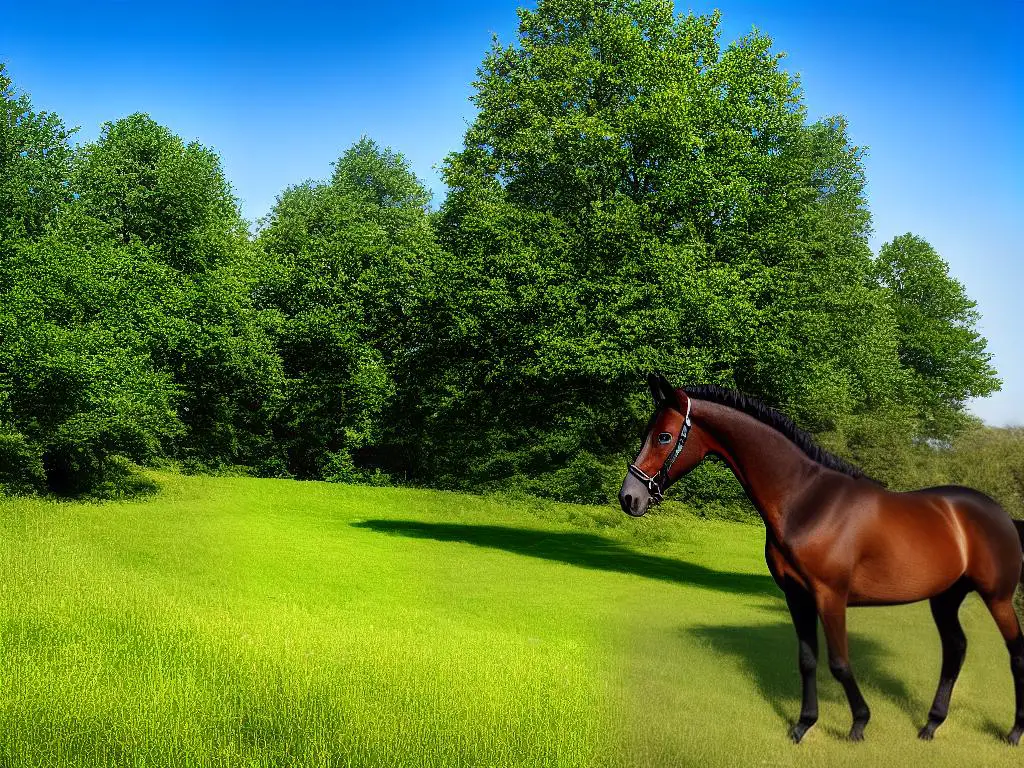
Features and Characteristics of German Warmbloods
Understanding German Warmblood Horses
German Warmblood horses represent an amalgamation of different horse breeds originating from Germany, all of which are registered with respective German breeding societies. These breeding organizations are dedicated to fostering the development of horses that exhibit a balanced temperament, superior movement, and are built for performing in various equestrian sports.
Physical Characteristics
German Warmbloods are noted for their impressive and diverse physical traits. These horses generally stand between 15.2 and 17.3 hands high, depending on the specific registry. They possess a strong and muscular well-built body, known for their strong back and well-formed neck. Their heads are expressive with large, kind eyes. They are found in all solid colors including bay, brown, chestnut, black, and occasionally grey. German Warmbloods have pleasing proportions, with a large frame that still allows for agility. They possess strong, lean legs with good bone density, and their feet tend to be hardy.
Performance Capacity
German Warmbloods are among the top-performing horses in various equestrian sports such as dressage, show jumping, eventing, and carriage driving. Due to the meticulous approach of German breeders in selectively pairing horses, German Warmbloods have consistently excelled on the international stage in various equestrian sports competitions. For instance, the Hanoverian breed has been rated highly among the breeders of show-jumping horses according to the World Breeding Federation for Sport Horses.
Temperament
The character and temperament of German Warmbloods are typically calm, willing, and intelligent. They are known for their versatility, trainable nature, and their dedication to the task at hand. While they are bred to be competitive, they still have an even keeled temperament in daily work. These breeds are such that experienced riders, as well as beginners, can handle them. The desired coolness of their temperament is one of the distinguishing factors when breeding German Warmbloods.
Distinct Attributes and Gait
German Warmbloods are recognized for their agility, power, and natural elasticity in their gaits. They possess a dominant trot and canter with powerful push from behind, athleticism, and a smooth ride. Warmbloods in general are bred for their ‘floating trot’, but German Warmbloods stand apart with an exceptional level of balance and impulsion.
Bloodlines
Studbooks that belong to the German Warmblood group all adhere to the same core breeding aim, but each organization also emphasizes certain qualities. These qualities are based on the bloodlines of their respective geographic area. Each individual breed has its own breeders’ society or Verband. Some of these breeders’ societies include the Hanoverian Verband, the Holsteiner Verband, the Oldenburg Horse Breeders’ Society, and the Westphalian Horse Studbook. These bloodlines are highly sought after for both their physical prowess and their appealing temperaments.
Introduction
German Warmbloods are renowned worldwide for their superior physical attributes, top-notch performance ability, and agreeable temperament. These versatile horse breeds owe much of their success to their meticulously managed diverse bloodlines. The structured approach to breeding and the careful maintenance of pedigree records ensures the preservation of these desirable traits, thereby solidifying the status of German Warmbloods as some of the world’s leading sport horses.
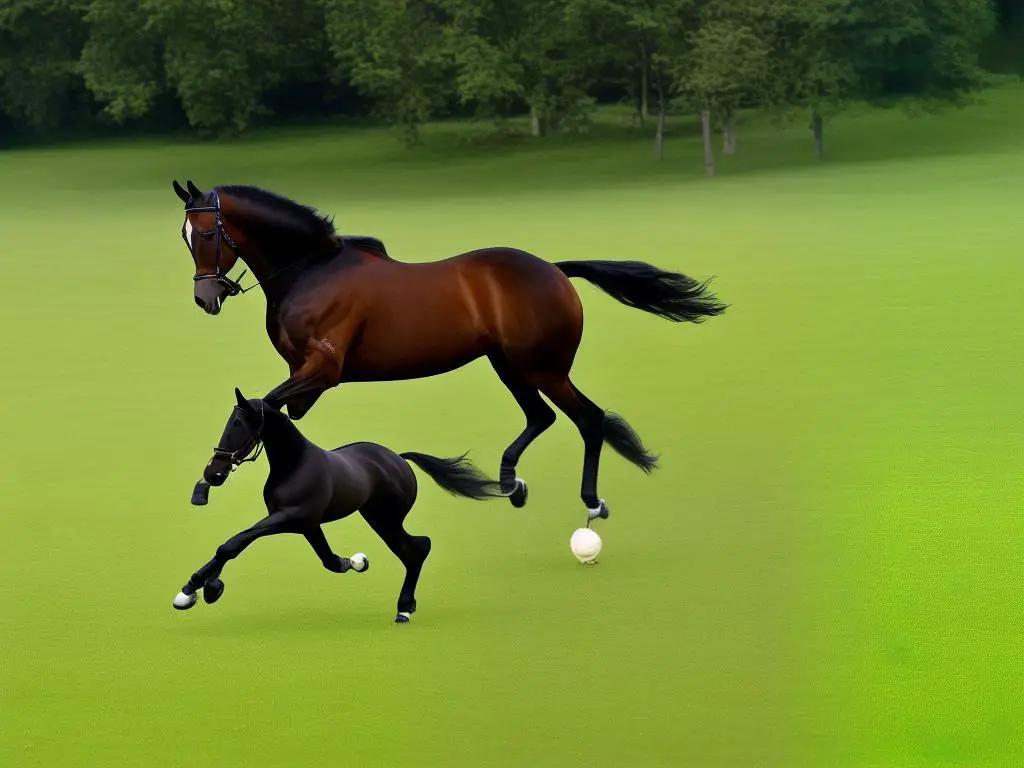
Main Bloodlines of German Warmbloods
Understanding the German Warmblood
Originating from Germany, the term “German Warmblood” covers a collection of horse breed registries. This includes distinctive breeds such as Hanoverian, Holstein, and Oldenburg. Each breed exhibits its own unique traits and strengths, which have been painstakingly nurtured through rigorous breeding regimes. These breeding programs are focused solely on the perpetual enhancement and preservation of their respective bloodlines.
Hanoverian Bloodline
The Hanoverian horse breed originated in the former kingdom of Hanover, now a part of Germany. Hanoverians have been carefully bred for many generations to excel in various equestrian activities such as show jumping, dressage, and eventing. With a typical height of 15.3 to 17.2 hands high, they are known for their sturdy build, gentle nature, and exceptional performance abilities. They are often bay, chestnut, black, or grey, and rarely have white markings. Notable horses from the Hanoverian bloodline include Salinero, an Olympic gold medalist in dressage, and Shutterfly, a world champion in show jumping.
Holstein Bloodline
The Holstein horse breed developed in the Schleswig-Holstein region of Germany. Famous for producing some of the world’s top show jumpers, the Holstein bloodline is one of the most influential in the sport horse world. Holsteiners are typically 16 to 17 hands high, with solid bodies and powerful hindquarters. Many are bay or black with less white markings. They are best known for their competitiveness, agility, and temperament. Holsteiners like Casall and Corrado I have had successful careers in the international showjumping circuit, further cementing the breed’s reputation.
Oldenburg Bloodline
The Oldenburg horse breed emerged in the Lower Saxony region of Germany. Unlike the Hanoverian and Holstein strains, Oldenburg horses are more variegated in their appearances, often showing more colors and patterns. They are particularly renowned for their athleticism, versatility, and outstanding movement. Oldenburg horses are typically larger, standing at 16.2 to 17.2 hands high, but despite their size, they’re known for their balanced gaits and elasticity. They have distinguished themselves not only in dressage and show jumping but also in driving. Horses like Donnerhall and Sandro Hit have contributed significantly to the prestige of the Oldenburg bloodline.
German Warmblood Breeding Programs
Originating from Germany, German Warmbloods possess an array of distinct and admirable characteristics, each derived from a diverse mix of bloodlines. The Hanoverian, Holstein, and Oldenburg breeds have made significant contributions to these traits and abilities, particularly in equestrian sports. Despite the distinctiveness of each breed, a consistent emphasis is placed on quality breeding practices. Whether it’s their agile movement, athletic prowess, or temperament, the superiority of these German horse breeds is indisputable. Thanks to precise breeding programs, not only are existing bloodlines preserved, but there’s also potential for new ones to emerge and develop.
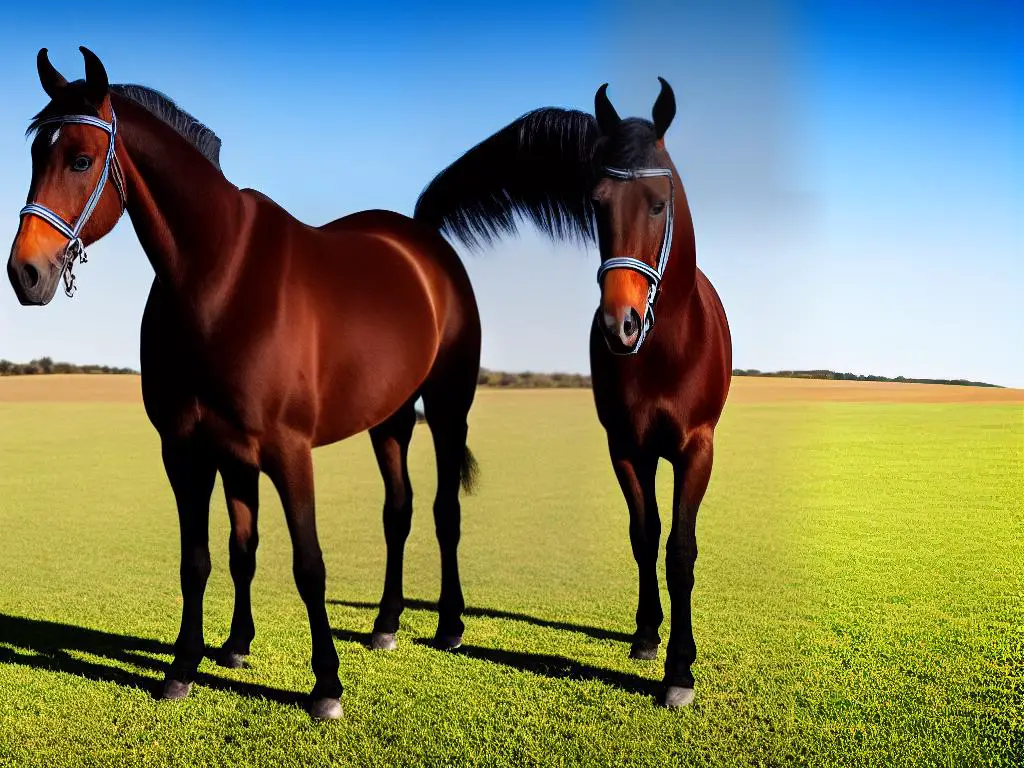
Breeding and Preservation of German Warmbloods
German Warmbloods: An Overview
In the realm of equestrian sports, German Warmblood breeds are admired for their exceptional athleticism and physical abilities. The enduring quality and purity of these breeds is a testament to stringent selection criteria, meticulous breeding practices, and persistent preservation efforts. Being aware of these processes can provide an in-depth understanding of the complexities involved in managing these bloodlines and adding to their continuing legacy.
Understanding What Makes a German Warmblood
Being referred to as a “German Warmblood” indicates the horse originates from a group of German breeds, such as Hanoverians, Holsteiners, Oldenburgs, and Westphalians. These breeds are celebrated for their strength, versatility, intelligence, and elegance. The label “warmblood” represents the balance between the speed-focused “hot-blooded” Thoroughbred horses and the strength-oriented “cold-blooded” draught horses.
The Intricacies of Breeding Practices and Selection Criteria
Over centuries, German Warmblood breeds have evolved through strategic selective breeding to excel in disciplines like dressage, show jumping, and eventing. This selection relies on a multitude of factors, including performance, soundness, conformation, temperament, and lineage.
Yearly inspections and performance tests are carried out to evaluate the stallions and mares to consider for breeding. These tests assess traits like trot, canter, and jumping abilities, as well as physical characteristics. This evaluation process helps select the best breeding candidates, ensuring the continuation of high-quality attributes and minimizing the risk of any inherent diseases being transmitted to the offspring.
Preservation of German Warmbloods
Preserving the purity and quality of German Warmbloods is vital. This is achieved through rigorous breeding guidelines established by each breed’s designated registry. By adhering to a rigid system of grading mares and stallions, registries ensure only the best specimens participate in the breeding program.
To prevent inbreeding, registries enforce genetic diversity practices. They maintain thorough stud books recording the ancestry details of each horse to conserve their respective bloodline. Thoroughbreds, Anglo-Arabians, and Trakehners’ historical influences, coupled with meticulous breeding control and preservation, have shaped today’s German Warmbloods.
Genetic health screening forms a key part of the preservation process. Most German Warmblood registries require frequent health tests for horses included in the breeding register. Routine screenings include checks for inherited diseases, genetic disorders, and overall fitness for breeding.
Understanding and assisting in the preservation and breeding processes for German Warmblood bloodlines can ensure the breed remains top contenders in equestrian sports. Their legacy, which has been cultivated over centuries, is dependent on the continuous dedication to uphold these high breeding standards. Only through careful preservation can the inherent athleticism, remarkable adaptability, and other traits that define German warmbloods be secured for generations to come.
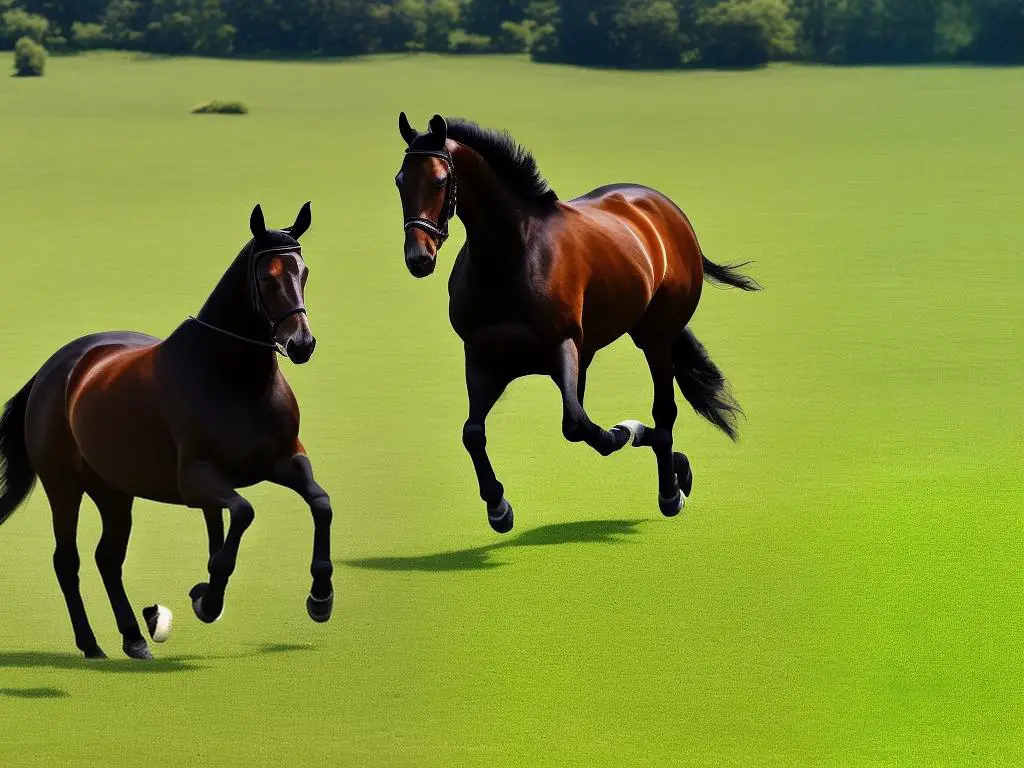
German Warmbloods in Equestrian Sports
Bearing a rich heritage, German Warmbloods originate from a variety of breeds collectively referred to as “warmbloods”, found in their native land of Germany. These esteemed horses are recognized for their “warm” temperament – falling between the calm demeanor of cold-blooded draft horses and the spirited nature of hot-blooded racehorses like the Arabian and Thoroughbred. Their exceptional blend of strength, stamina, and speed equips them perfectly for a range of equestrian sports, particularly excelling in the disciplines of dressage, show jumping, and eventing.
German Warmbloods in Dressage
Dressage is often considered the pinnacle of equestrian sports, requiring the ultimate connection, harmony, and communication between horse and rider. The Hanoverian, a German Warmblood breed, has been a stand-out performer in this sport for years. The breed is highly sought-after for dressage due to its strong, powerful gaits, exceptional trainability, and willingness to work. Hanoverians have won multiple gold medals at the Olympic Games in dressage, cementing their legacy in the sport.
German Warmbloods in Show Jumping
In the field of show jumping, another German Warmblood breed, the Holsteiner, has made a significant mark. Bred for over 700 years in the Schleswig-Holstein region of Germany, Holsteiners are recognized for their power, agility, and courage – traits that suit them well for the intense athleticism needed in show jumping. They have produced countless international show jumping champions, with their impeccable jumping form and keen instincts.
German Warmbloods in Eventing
Eventing, combining dressage, cross-country, and show jumping into one challenging competition, tests the versatility, endurance, and bravery of a horse. Popular German Warmblood breeds for eventing include the Trakehner and Hanoverian. The Trakehner, with its Thoroughbred influence, provides speed and stamina for the tough cross-country phase, while still possessing the movement and trainability for dressage.
In addition to breed-specific performances, German Warmbloods in general have a comprehensive systematic approach to their breeding, allowing them to continually produce top performance horses. Breeding approval requires passing strict conformation and performance tests, ensuring that only the best of each breed contribute to the next generation.
The German Warmblood bloodlines’ success in equestrian sports is not simply down to chance or sporadic breeding. It’s a combination of a diligent, well-structured breeding program, keen selection for specific traits, and methodical nurturing and training of these horses for their designated sports. This strategy has allowed these breeds to continuously produce top-level competitors, sustaining their reputation in the global equestrian sports world.
These majestic horses – defined by their dynamism, versatility, and athleticism – are more than just a symbol of equestrian sports in Germany. They embody the long-standing tradition that emphasizes the inseparable bond between the horse and rider. As they continue to grace arenas worldwide, German Warmbloods remain a testament to the high standards of horse breeding, underscoring the value of hard work, discipline, patience, and passion in the realm of equestrian sports. This legacy is preserved and continues to thrive in their bloodlines, illustrating the exquisite blend of strength, finesse, and spirit that defines German Warmbloods.
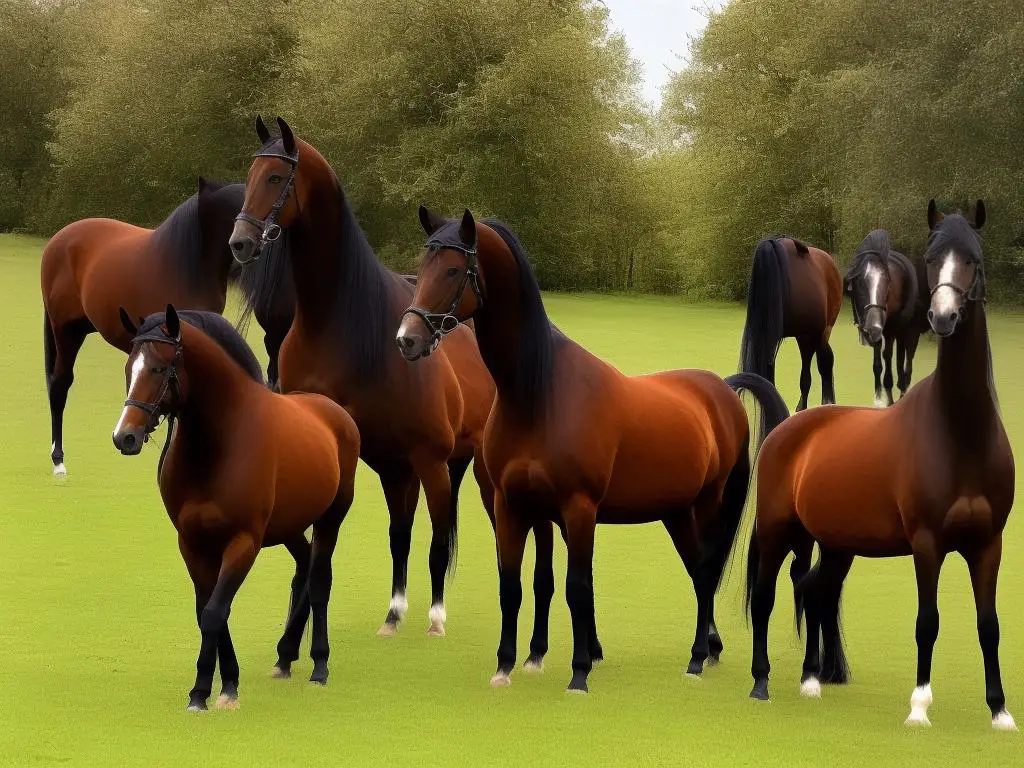
The world of German Warmbloods is truly captivating, offering a rich source of historical, cultural, and sporting stories. Their legacy, shaped by meticulous breeding and preservation practices, echoes prominently through their distinguished bloodlines like Hanoverian, Holstein, and Oldenburg. These bloodlines have given the global equestrian community versatile horses that excel in various sporting events, from dressage to show jumping. As we chart the journey of these magnificent creatures, appreciating their contribution to equestrian sports, and the characteristics that make them remarkably unique, we are reminded that German Warmbloods are not just horses – they are a testament to Germany’s equestrian heritage and the unyielding pursuit of excellence.